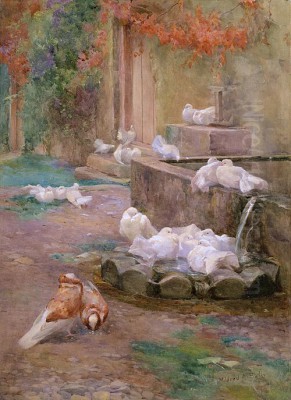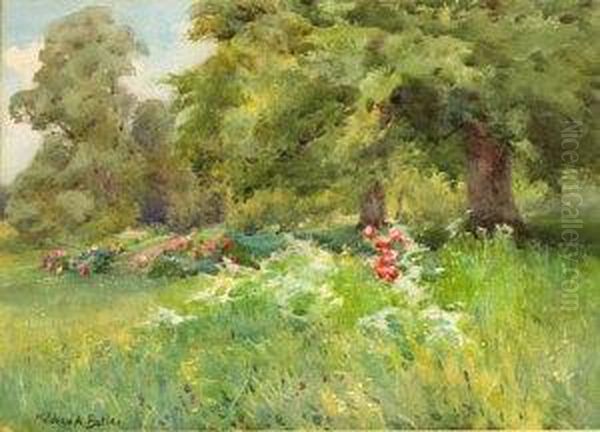
Mildred Anne Butler stands as one of Ireland's most cherished artists from the late nineteenth and early twentieth centuries. Born in 1858 and passing away in 1941, she dedicated her artistic life primarily to watercolour, capturing the intimate beauty of her surroundings with remarkable sensitivity and skill. An Irish national, Butler emerged during a time when professional careers for women artists were still gaining ground, making her achievements particularly noteworthy. Her work, focused predominantly on nature, gardens, animals, and domestic scenes, continues to resonate with audiences for its vibrant depiction of light, colour, and the quiet moments of life in rural Ireland.
Early Life and Artistic Formation
Mildred Anne Butler was born into a privileged environment at Kilmurry House, Thomastown, County Kilkenny. Her family was well-established and possessed considerable means, which afforded her opportunities often unavailable to others at the time. Her father, Captain Henry Butler, was himself an amateur artist with an interest in landscape and natural history, providing an early artistic influence. The environment of Kilmurry, with its extensive gardens, surrounding woodlands, and abundant wildlife, became the crucible for her artistic development.
From a young age, Butler displayed a keen interest in observing and sketching the world around her. The flora and fauna of the Kilmurry estate offered endless subjects. Unlike many artists who sought dramatic or exotic landscapes, Butler found profound inspiration in the familiar. The gardens her family cultivated, the birds that frequented them, and the domestic and farm animals became her primary muses. This deep connection to her home ground would remain a defining characteristic of her art throughout her long career.
Her upbringing provided not only inspiration but also the resources for formal training. The family's social standing and appreciation for the arts likely encouraged her pursuits. This supportive background was crucial in enabling her to develop her talent and eventually pursue art professionally, navigating the societal expectations of her time for women of her class. The foundation laid at Kilmurry – a love for nature combined with an environment conducive to artistic exploration – shaped her unique vision.
Education and Influences

To refine her innate talent, Mildred Anne Butler sought formal art education, initially travelling to London. She enrolled at the prestigious Westminster School of Art, where she would have received grounding in drawing and painting techniques. This period in London exposed her to a wider artistic milieu and likely solidified her commitment to an artistic career. Following her London studies, around 1885, she embarked on travels across Continental Europe, visiting France, Switzerland, and Italy.
These travels were crucial for broadening her artistic horizons. In Europe, she sought further instruction, studying under the notable watercolourist Paul Jacob Naftel, known for his landscape work. This mentorship would have honed her skills specifically in the watercolour medium. Significantly, Butler also spent time studying alongside fellow Irish artist Rose Barton, with whom she shared an interest in capturing light and atmosphere. Both artists were drawn to the principles of en plein air painting, a practice popularized by French artists.
The influence of French art, particularly the emphasis on painting outdoors to capture the fleeting effects of light and colour, is evident in Butler's work. While not strictly an Impressionist, her style shows an affinity with the movement's focus on light, her use of vibrant colour, and sometimes broken brushwork, adapted to the watercolour medium. She absorbed these contemporary trends but integrated them into her own distinct style, rooted in the specific environment of Kilkenny rather than the landscapes of Barbizon or Argenteuil associated with figures like Jean-Baptiste-Camille Corot or Claude Monet.
Artistic Style and Subject Matter
Mildred Anne Butler is celebrated primarily for her mastery of watercolour. Her technique involved confident washes, often layered to create depth and luminosity, combined with finer details where needed. She possessed an exceptional ability to capture the interplay of light and shadow, bringing vibrancy and life to her scenes. Her palette was often bold and rich, moving beyond the purely topographical to convey mood and atmosphere.
A distinctive feature of Butler's work is her frequent use of unconventional viewpoints. She often painted scenes looking down from an elevated position, such as a hillside or an upper window of Kilmurry House. This perspective offered dynamic compositions and a different way of seeing familiar subjects, flattening the pictorial space in ways that echo some modern art developments, while still remaining firmly representational.

Her subject matter remained remarkably consistent throughout her career, centred on the life and nature within and around Kilmurry. Gardens bursting with flowers, such as phlox and lilac, were favourite themes. She painted the estate's birds with particular affection – pigeons congregating on rooftops, majestic peacocks displaying their plumage, and common garden birds. Cattle grazing in pastures, horses, and beloved domestic pets also feature prominently, depicted with unsentimental accuracy yet clear fondness. These were not just studies of animals and plants; they were portraits of the life that animated her world.
The Kilmurry Context
Kilmurry House was more than just a home for Mildred Anne Butler; it was her primary studio, her sanctuary, and the inexhaustible source of her artistic inspiration. The vast majority of her known works depict scenes from the house, its gardens, and the immediate surrounding countryside. This deep immersion in a single locale allowed her to develop an intimate understanding of its rhythms, its changing seasons, and the subtle shifts in light throughout the day.
Her paintings often convey a strong sense of place and belonging. Works like Garden at Kilmurry are not generic garden scenes but specific, lovingly rendered portraits of her own environment. She painted the familiar pathways, the specific arrangements of flowerbeds, the textures of stone walls, and the architecture of the house itself. This intimacy lends her work a personal and authentic quality that distinguishes it from more detached landscape painting.
The domestic sphere also featured in her work. While renowned for outdoor scenes, she occasionally depicted interiors or scenes viewed from windows, blurring the line between inside and outside. These works often include elements of the natural world – a pet bird near a window, flowers brought indoors – reinforcing the connection between the domestic environment and the surrounding nature that was so central to her life and art. Kilmurry provided the stage upon which the quiet dramas of nature and daily life unfolded, and Butler was its most devoted chronicler.
Career Development and Exhibitions
Mildred Anne Butler pursued her art with professionalism and ambition. Her career gained momentum through regular exhibitions in Ireland and Britain. She first exhibited with the Society of Artists in Belfast and soon began showing her work in major London venues. The Dudley Gallery was an important early platform, showcasing watercolourists and graphic artists. Her participation here signalled her entry into the professional art world.
She became a regular exhibitor at the prestigious Royal Academy in London, a significant achievement for any artist, particularly a woman at that time. While she exhibited there frequently, it's important to note she was not elected a member of the RA itself. However, her skill in watercolour earned her recognition from specialist societies. In 1896, she was elected an Associate of the Royal Society of Painters in Water Colours (ARWS), a major honour, and achieved full membership (RWS) later in 1937.
In Ireland, she exhibited with the Royal Hibernian Academy (RHA) and was an active member of the Water Colour Society of Ireland (WCSI), contributing to its exhibitions alongside contemporaries like Percy French. A pivotal moment came in 1896 when her painting Morning Glow (sometimes referred to as The Morning Bath) was purchased for the nation by the Chantrey Bequest. This acquisition, facilitated by the Royal Academy, cemented her reputation and brought her work into the prestigious Tate collection in London, significantly raising her profile.
Connections and Collaborations
Throughout her career, Mildred Anne Butler engaged with the wider artistic community. Her visits to the Newlyn Art Colony in Cornwall in 1894 and 1895 are significant. This colony was a hub for artists interested in plein air painting and depicting rural life, aligning with Butler's own interests. While there, she interacted with key figures of the Newlyn School. She formed friendships with artists like Sir John Lavery, the renowned portraitist and war artist, and Walter Osborne, a fellow Irish artist deeply involved with the Newlyn movement.
Other Newlyn associates included Stanhope Forbes, a founder of the school known for his social realist scenes, and Norman Garstin. Her connection with Rose Barton, with whom she had studied earlier, was likely reinforced through shared interests with the Newlyn ethos. Butler also associated with the Irish artist May Guinness, who, like Butler, navigated the opportunities and challenges for women artists of their generation.
Beyond Newlyn, her collaboration extended to joint exhibitions. In 1907, she held a significant two-person show with the popular Irish entertainer, songwriter, and watercolourist Percy French at the New Dudley Gallery in London. This pairing highlights her standing in the Irish art scene and her connection to fellow members of the Water Colour Society of Ireland. While primarily based in Kilkenny, these connections demonstrate her awareness of and participation in broader artistic currents, placing her work in dialogue with contemporaries like Nathaniel Hone the Younger and Sarah Purser, who were central figures in the Dublin art world.
Themes and Interpretation
While Mildred Anne Butler's work primarily celebrates the beauty of nature and rural life, some pieces invite deeper interpretation. Her paintings are rarely overtly narrative or allegorical, yet they sometimes contain subtle layers of meaning or social observation. Her focus on enclosed gardens and domestic animals can be seen as reflecting the circumscribed world often available to women artists of her era, yet she imbued these subjects with dignity and profound visual interest.
The painting Ancient Rubbish stands out as a work hinting at broader themes. Depicting a cluttered interior space filled with discarded objects and furniture, possibly within Kilmurry, it has been interpreted as a commentary on decay, the passage of time, or even the decline of the Anglo-Irish Ascendancy class to which her family belonged. The title itself suggests a reflection on value and neglect. However, Butler's approach remains observational rather than didactic, allowing viewers to draw their own conclusions.
Her meticulous depiction of flora and fauna also reflects a keen, almost scientific interest in the natural world. This aligns with her father's interests and the broader Victorian fascination with natural history. Her election as an honorary member of the Royal Dublin Society (RDS), an institution promoting science, arts, and agriculture in Ireland, acknowledges this aspect of her work and her contribution beyond purely aesthetic concerns. Her art, while deeply personal, subtly touches upon themes of heritage, nature, and the quiet observation of life's details.
Recognition and Patronage
Mildred Anne Butler achieved considerable recognition during her lifetime, both in Ireland and internationally. Her regular presence at major exhibitions in London and Dublin ensured her work was seen by critics, collectors, and the public. The purchase of Morning Glow by the Chantrey Bequest was a significant mark of official acclaim, placing her alongside prominent British artists in a national collection.
Her work also attracted royal and aristocratic patronage, further enhancing her reputation. Queen Mary, consort of King George V, was known to admire and purchase her paintings. The Grand Duke of Hesse, a relative of the British royal family, was another notable patron. This high-level interest underscores the appeal of her charming and skilfully executed watercolours, which captured an idyllic vision of rural life that resonated with elite tastes.
Despite living a relatively secluded life based primarily at Kilmurry, Butler managed to build and maintain an international reputation. Her election to the Royal Society of Painters in Water Colours confirmed her standing among the leading practitioners of the medium in Britain. She successfully navigated the art market, selling her works consistently and establishing herself as one of Ireland's most successful professional female artists of the period.
Later Years and Legacy
Mildred Anne Butler remained devoted to her art for most of her life. However, in her later years, she suffered from severe arthritis, which eventually made the delicate work required for watercolour painting increasingly difficult. This condition sadly forced her to cease painting towards the end of her life, a difficult reality for such a dedicated artist.
During her later years, she undertook travels, including visits to family members who had emigrated to Canada. These trips provided a change of scene, but her heart remained at Kilmurry. She eventually returned to her beloved home in County Kilkenny. Mildred Anne Butler passed away at Kilmurry House in 1941, leaving behind a substantial body of work dedicated almost entirely to the place that had nurtured her talent.
Her legacy endures today. Mildred Anne Butler is celebrated as a leading figure in Irish art and one of the foremost watercolourists of her generation. Her paintings are admired for their technical brilliance, their sensitivity to light and atmosphere, and their affectionate portrayal of the natural world. She holds a significant place as a pioneering professional woman artist in Ireland, whose dedication to her craft and unique vision created a lasting and cherished contribution to the nation's artistic heritage. Her works remain popular at auction and are held in major public collections in Ireland and the UK.
Conclusion
Mildred Anne Butler's art offers a window into a specific world – the gardens, fields, and life of Kilmurry House in County Kilkenny. Through her masterful handling of watercolour, she elevated everyday scenes into captivating works of art, filled with light, colour, and keen observation. Her dedication to her chosen subjects, combined with her technical skill and subtle artistic vision, secured her reputation during her lifetime and ensures her continued appreciation. As one of Ireland's most important early professional women artists, her life and work provide inspiration, demonstrating how a deep connection to place can fuel a rich and enduring artistic legacy. Her paintings continue to charm viewers with their intimate portrayal of nature and the quiet beauty of rural Irish life.